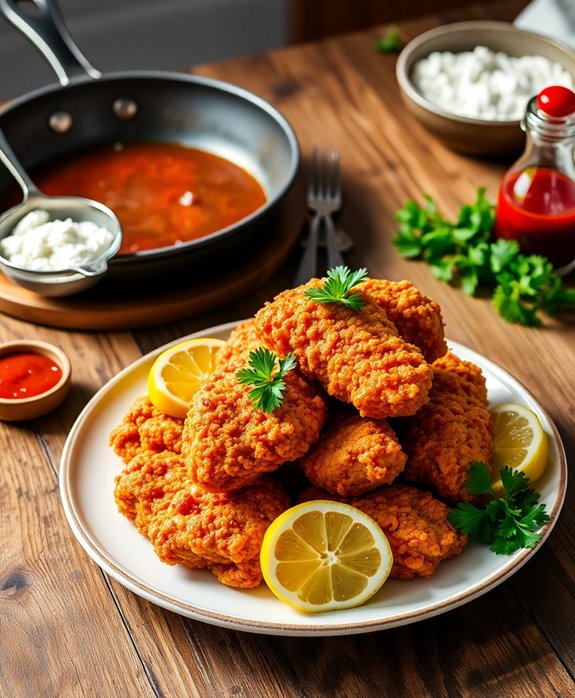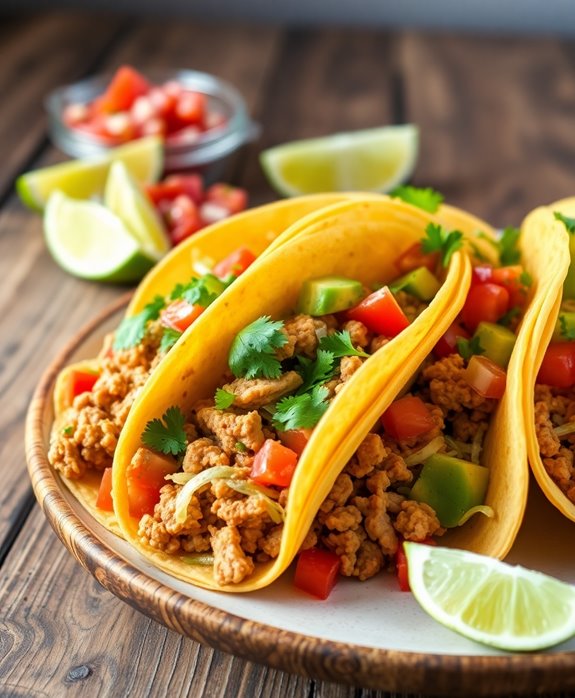You might think macro-friendly chicken recipes are bland, but that’s simply not the case. With the right approach, you can create dishes that are both nutritious and packed with flavor. Imagine transforming simple chicken into a culinary experience through the use of spices, herbs, and healthy cooking techniques.
As you explore various recipes, you’ll discover how easy it is to maintain balance in your meals while keeping things interesting. What are some of the surprising ingredients you can incorporate to elevate your chicken dishes?
Tips and Tricks
- Use skinless, boneless chicken breasts marinated in olive oil, lemon, garlic, and herbs for a flavorful, macro-friendly dish.
- Opt for grilling or baking methods to keep the calorie count low while retaining the chicken’s moisture and texture.
- Enhance nutrition by pairing chicken with a variety of colorful vegetables, increasing fiber content and essential nutrients.
- Incorporate healthy fats, like olive oil, to improve satiety and flavor without significantly impacting calorie intake.
- Plan meals by batch cooking chicken with different marinades to ensure variety and meet your macro goals throughout the week.
History
When you think about macro-friendly chicken recipes, it’s interesting to reflect on their evolution over time. Historically, chicken has been a staple protein source across various cultures, valued for its affordability and versatility.
As culinary evolution progressed, so did the methods of preparation and flavors associated with chicken dishes. In the past, many traditional recipes emphasized rich, heavy sauces and frying techniques, which often overshadowed the health benefits of chicken.
In recent years, there’s been a shift toward healthier cooking methods, driven by an increased awareness of nutrition and dietary needs. This shift focuses on leaner cuts of chicken, such as breasts and thighs, which provide high protein while minimizing fat content.
You might notice that modern recipes often incorporate fresh herbs, spices, and vegetables, enhancing flavor without adding excessive calories.
The rise of macro-friendly approaches reflects broader dietary trends that prioritize balanced macronutrient intake, encouraging you to contemplate not just protein but also carbohydrates and fats. Additionally, many people are now exploring low FODMAP chicken recipes, which cater to specific dietary restrictions while still being delicious.
Recipe

Macro Friendly Chicken Recipes
Chicken is a versatile and nutritious source of protein, making it a beloved staple in many diets, especially for those focused on fitness and healthy eating. This macro-friendly chicken recipe isn’t only easy to prepare but also packed with flavor and essential nutrients.
Whether you’re meal prepping for the week or looking for a quick dinner option, this dish will satisfy your taste buds without compromising your dietary goals.
In this recipe, we’ll be preparing a zesty lemon herb chicken that’s perfect for grilling or baking. The combination of fresh herbs and the bright acidity of lemon brings out the natural flavors of the chicken, making it a delightful option for any meal.
Serve it with steamed vegetables or a light salad for a complete, macro-friendly feast.
Ingredients:
- 4 boneless, skinless chicken breasts
- 2 tablespoons olive oil
- Juice of 2 lemons
- Zest of 1 lemon
- 3 cloves garlic, minced
- 1 teaspoon dried oregano
- 1 teaspoon dried thyme
- Salt and pepper to taste
- Fresh parsley for garnish (optional)
Cooking Instructions:
In a large bowl, combine olive oil, lemon juice, lemon zest, minced garlic, oregano, thyme, salt, and pepper.
Add the chicken breasts to the marinade, ensuring they’re well coated. Allow the chicken to marinate for at least 30 minutes, or up to 2 hours for maximum flavor.
Preheat your grill or oven to medium-high heat. If grilling, cook the chicken for 6-7 minutes per side, or until the internal temperature reaches 165°F.
If baking, place the chicken in a preheated oven at 375°F and bake for 25-30 minutes. Once cooked, let the chicken rest for a few minutes before slicing and serving.
Extra Tips:
To enhance the flavor even further, consider adding fresh herbs like rosemary or basil to the marinade.
Additionally, if you want to add some heat, a pinch of red pepper flakes can be included.
Make sure to let the chicken rest after cooking to keep it juicy and tender.
For meal prep, this chicken can be stored in the refrigerator for up to 4 days and reheats well, making it a convenient option for busy weekdays.
Moreover, using Parmesan crusting can elevate the dish, adding a crispy texture and rich flavor to the chicken.
Cooking Steps
To create delicious macro-friendly chicken dishes, start by preparing your chicken breast fillets. Season them with your favorite spices for added flavor, and then cook on medium heat to guarantee even doneness. Don’t forget to add vegetables during the cooking process to enhance taste and nutrition, and let the chicken rest before serving for ideal juiciness. Additionally, using frozen chicken can save you time and ensure a tender result when cooked slowly in a crock pot.
Step 1. Prepare Chicken Breast Fillets

Preparing chicken breast fillets is a straightforward process that can lead to delicious and nutritious meals. Start by selecting high-quality, boneless, skinless chicken breast fillets, which are low in fat and high in protein. Rinse the fillets under cold water and pat them dry with a paper towel.
Next, consider your marinade options, which can enhance flavor and tenderness. Simple marinades can include olive oil, lemon juice, garlic, and herbs. Let the chicken marinate for at least 30 minutes or up to a few hours in the fridge for the best results. For a different flavor profile, you could also try adding savory rosemary to your marinade for a fragrant twist.
When it comes to cooking methods, you’ve got a few choices. Grilling is a popular option, imparting a smoky flavor while keeping the fillets juicy. Alternatively, you can bake the chicken at 375°F (190°C) for about 20-30 minutes, depending on thickness, or sauté it in a skillet over medium heat for a quicker option.
Always check for an internal temperature of 165°F (75°C) to verify the chicken is fully cooked. With these steps, you’ll have perfectly prepared chicken breast fillets ready for any macro-friendly meal!
Step 2. Season With Spices

How can you elevate the flavor of your chicken breast fillets? One of the best ways is to season them with spices. Using various spice combinations not only enhances the taste but also introduces exciting flavor profiles to your dish.
Start by choosing a base spice, like garlic powder or paprika, which can serve as the foundation. From there, consider adding herbs such as oregano or thyme to bring depth.
Experiment with spice blends like Italian seasoning or Cajun mix, which can provide a balanced mix of flavors without overwhelming your chicken. Don’t forget to incorporate a touch of salt and pepper, as they can greatly enhance the overall taste.
When you combine spices, think about how they complement each other; for instance, a combination of cumin and coriander can add a warm, earthy note. Additionally, incorporating ground chicken recipes can offer more options for protein-packed meals that are flavorful and nutritious.
Always remember to season generously, but taste as you go. The right balance is key, so adjust based on your preference.
Step 3. Cook on Medium Heat

After seasoning your chicken breast fillets to enhance their flavor, the next step is cooking them properly. Opt for medium heat when using cooking methods like pan-searing or grilling. This temperature allows for even cooking, ensuring your chicken is tender and juicy without drying it out. Medium heat strikes a balance, promoting better heat control, which is vital for achieving that perfect golden-brown crust while keeping the inside moist.
Start by preheating your skillet or grill. Once it reaches the desired temperature, add the fillets. Avoid overcrowding the pan, as this can drop the temperature and cause uneven cooking. Cook each side for about five to seven minutes, flipping only once to maintain a good sear. You can check doneness with a meat thermometer; chicken should reach an internal temperature of 165°F (75°C).
Using medium heat also reduces the risk of burning the outside while leaving the inside undercooked. If you notice the chicken browning too quickly, lower the heat slightly and adjust your cooking time accordingly.
This careful heat control is essential for achieving delicious, macro-friendly chicken every time. Additionally, you can enhance the flavor of your chicken by incorporating spices typical of spicy hibachi chicken, which can elevate your home-cooked meals.
Step 4. Add Vegetables for Flavor

Why not elevate your chicken dishes by adding a variety of vegetables? Incorporating vegetables not only enhances the flavor but also boosts the nutritional value of your meal. You can choose from a wide range of options, like bell peppers, zucchini, broccoli, or carrots, each providing unique flavors and textures.
Start by sautéing your chosen vegetables in a bit of olive oil before adding the chicken. This method allows the vegetables to soften, releasing their natural sugars and creating a rich, flavorful base. As the vegetables cook, they infuse the chicken with their essence, resulting in a more complex and satisfying dish.
In addition, vegetables bring a wealth of benefits to your meals. They’re packed with vitamins, minerals, and antioxidants, which can support overall health. Furthermore, adding veggies can help increase fiber content, making your meal more filling and satisfying. For instance, the combination of chicken and vegetables can create a dish reminiscent of chicken nanban, a flavorful Japanese delight.
Finally, consider seasoning your vegetables with herbs and spices that complement the chicken, like garlic, thyme, or paprika. This combination not only enhances the flavor but also makes your chicken dishes more vibrant and appealing.
Step 5. Let Rest Before Serving

Allowing your chicken to rest for a few minutes before serving is essential for achieving perfect flavor and texture. When you cook chicken, the juices inside begin to move toward the center. If you slice into it right away, those juices escape, leading to dry meat.
Resting benefits your chicken by allowing the juices to redistribute throughout, resulting in a moist and tender dish. Aim for a resting time of about 5 to 10 minutes, depending on the size of your chicken. During this period, the internal temperature will continue to rise slightly, which helps reach the ideal serving temperature.
The USDA recommends a minimum internal temperature of 165°F for poultry, so resting can assist in ensuring your chicken is safe to eat while remaining juicy. Additionally, resting your chicken can enhance the overall experience, much like the Delicious Chicken Divan With Sherry and Parmesan Delight which showcases how proper resting can elevate flavors.
Moreover, resting doesn’t just enhance texture; it also intensifies flavors. As the chicken cools slightly, the flavors meld together, creating a more satisfying experience.
Nutrition Facts
When it comes to enjoying macro-friendly chicken recipes, understanding the nutrition facts is essential for making informed choices. Chicken is a fantastic protein source, providing essential amino acids that support muscle repair and growth. A typical serving of skinless, boneless chicken breast contains around 165 calories and 31 grams of protein, making it an excellent choice for those aiming to hit their macro targets.
Pay attention to the caloric content of your recipes, as preparation methods can greatly impact nutrition. For example, frying chicken may increase calories due to added fats, while grilling or baking keeps it lean.
Additionally, consider the accompanying ingredients. Adding vegetables not only boosts the nutrient density but also helps maintain a balanced meal.
When you combine chicken with healthy fats, like olive oil or avocado, you create a more satisfying dish that can help with satiety. Incorporating ground chicken into your meals can also provide a versatile and delicious option for various recipes, making it easier to stick to your dietary goals.
Don’t forget to factor in carbohydrates if you’re aiming for a specific macro split. By understanding these nutrition facts, you can tailor your meals to fit your dietary goals while still enjoying delicious chicken recipes.
Final Thoughts
In the quest for healthy eating, embracing macro-friendly chicken recipes can greatly enhance your meal planning. By focusing on balanced nutrition, you not only fuel your body but also enjoy delicious meals.
Chicken is a versatile protein that adapts well to various flavor combinations, making it easy to keep your meals exciting and satisfying. For instance, incorporating Southern Chicken and Rice into your weekly menu adds a comforting touch to your rotation.
When you integrate these recipes into your routine, meal prep becomes a breeze. You can batch-cook chicken with different marinades or seasonings, ensuring you have a variety of options throughout the week. This approach not only saves time but also helps you stick to your nutritional goals.
Remember, the key to maintaining a healthy diet is consistency, and having macro-friendly meals ready to go can make all the difference. Experiment with herbs, spices, and different cooking methods to discover what you love.
Ultimately, embracing these recipes can lead to better eating habits without sacrificing flavor. So, get creative in the kitchen, and let your taste buds guide you as you make healthy choices.
With macro-friendly chicken recipes, you can enjoy meals that are both nutritious and delicious, supporting your journey towards a healthier lifestyle.
Frequently Asked Questions
Can I Substitute Chicken With Other Proteins in These Recipes?
Yes, you can absolutely substitute chicken with alternative proteins like turkey, tofu, or legumes. Just consider recipe adaptations to guarantee proper flavor and cooking times, and you’ll achieve delicious results without losing nutritional balance.
How Do I Store Leftovers From These Chicken Dishes?
When it comes to leftover storage, you’ve gotta think ahead. Use airtight containers for your chicken dishes, and refrigerate them within two hours. Follow these chicken tips, and you’ll keep them fresh for up to four days.
Are These Recipes Suitable for Meal Prep?
Yes, these recipes are perfect for meal prep. You’ll enjoy meal prep benefits like time-saving and portion control, ensuring you eat balanced meals throughout the week while avoiding food waste. Enjoy your organized and nutritious meals!
What Cooking Methods Can I Use Besides Baking or Grilling?
Ever wondered how to add variety to your cooking? You can try sautéing techniques for quick flavor or poaching methods for tender results. Both methods keep your meals healthy and delicious without relying solely on baking or grilling.
Can I Make These Recipes Gluten-Free?
Yes, you can definitely make these recipes gluten-free. Use gluten-free substitutes like almond flour or coconut flour as alternatives. Just guarantee you adjust cooking times and techniques for best results, maintaining flavor and texture.







